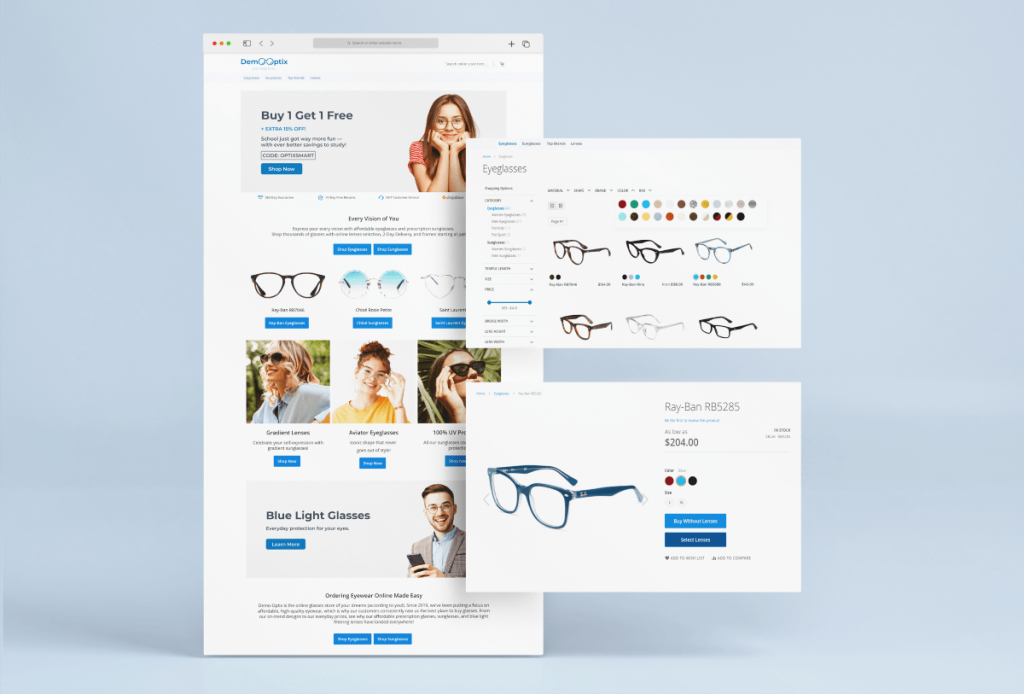Starting your eyewear brand is an exciting venture that combines creativity with business acumen. As the eyewear industry continues to evolve and grow, 2024 offers a prime opportunity to launch a new brand. This comprehensive guide will take you through the essential steps to build a successful eyewear business from the ground up.
Step 1: Plan and Set Goals
The first step to start your eyewear brand is to create a detailed plan and strategy. This involves defining your brand’s mission, vision, and values. Ask yourself what motivates you to enter the eyewear industry and what unique perspective your brand will bring. Set both short-term and long-term goals to guide your progress.
- Market Positioning: Decide where your brand will fit within the market. Will you focus on luxury eyewear, affordable everyday wear, sports eyewear, or perhaps eco-friendly options? Understanding your niche will help tailor your products and marketing efforts.
- SWOT Analysis: Conduct a SWOT analysis (Strengths, Weaknesses, Opportunities, Threats) to assess your business environment. This will help you identify potential challenges and opportunities early on.
Step 2: Analyze Your Market
In-depth market research is crucial for understanding the dynamics of the eyewear industry. This includes analyzing market trends, consumer behavior, and key competitors.
- Consumer Insights: Identify your target audience. Consider factors such as age, gender, lifestyle, and purchasing behavior. What are their preferences when it comes to eyewear styles, materials, and brands?
- Competitive Analysis: Study your competitors to understand their strengths and weaknesses. Look at their product offerings, pricing strategies, marketing tactics, and customer reviews. This will help you identify gaps in the market that your brand can fill.
Step 3: Develop Your Brand Identity
Creating a strong brand identity is essential for standing out in a crowded market. Your brand identity should resonate with your target audience and communicate your brand’s values and personality.
- Brand Name and Logo: Choose a memorable brand name and design a logo that reflects your brand’s essence. Your logo should be versatile enough to be used on various platforms and marketing materials.
- Visual and Verbal Identity: Develop a cohesive visual identity, including color schemes, typography, and imagery that align with your brand. Additionally, establish a brand voice that will be used across all communications—whether it’s friendly, professional, quirky, or sophisticated.

Step 4: Create an Eyewear Brand Business Plan
A well-structured business plan is crucial for outlining your business strategy and securing potential investors or loans. Your business plan should include detailed sections on various aspects of your business.
- Executive Summary: Provide an overview of your business, including your mission statement, product offerings, and key objectives.
- Market Analysis: Present your findings from market research, including target market, competitive landscape, and market needs.
- Marketing Strategy: Outline your plans for branding, advertising, social media, and public relations. Specify your budget for marketing activities.
- Financial Projections: Include detailed financial projections, including startup costs, revenue forecasts, profit margins, and break-even analysis. This will demonstrate the financial viability of your business to potential investors.
Step 5: Choose Your Eyewear Products
Choosing the right products is critical for attracting and retaining customers. Your product selection should reflect your brand identity and meet the needs of your target market.
- Product Range: Decide on the types of eyewear you will offer. This could include prescription glasses, sunglasses, sports eyewear, or specialty lenses like blue light blocking glasses.
- Design and Quality: Collaborate with designers and manufacturers to create stylish and high-quality eyewear. Consider using durable and sustainable materials to appeal to environmentally conscious consumers.
- Pricing Strategy: Develop a pricing strategy that aligns with your brand positioning and target market. Ensure your prices cover costs and provide a reasonable profit margin while remaining competitive.
Step 6: Select eCommerce Platform
Selecting the right eCommerce platform is crucial for the success of your online store. Magento, now known as Adobe Commerce, is a leading eCommerce platform that offers numerous benefits for your eyewear business.
- Customization and Flexibility: Magento is highly customizable, allowing you to tailor your online store to your specific needs. You can create a unique shopping experience that reflects your brand identity.
- Scalability: As your business grows, Magento can scale with you. It can handle a large catalog of products and high volumes of traffic, ensuring your website remains fast and responsive.
- Integration Capabilities: Magento integrates with numerous third-party services, including payment gateways, shipping providers, and marketing tools. This makes it easier to manage your business operations from one platform.
- SEO and Marketing Tools: Magento offers built-in SEO features and marketing tools to help drive traffic to your site. You can optimize your product pages, create promotional campaigns, and analyze customer data to improve your marketing strategies.
- Community and Support: Magento has a large community of developers and users, providing a wealth of resources and support. Adobe Commerce also offers professional support and training to help you get the most out of the platform.
Step 7: Create Your Eyewear Website
Your website is the digital storefront of your brand. It needs to be visually appealing, user-friendly, and optimized for conversions.
- Design and UX: Invest in professional web design to create a visually stunning and intuitive website. Ensure that the site is responsive, so it works well on both desktop and mobile devices.
- Product Pages: Create detailed and attractive product pages with high-quality images, thorough descriptions, and customer reviews. Include options for customers to customize their eyewear, such as selecting frame colors and lens types.
- Secure Payments: Implement secure payment gateways to build trust with your customers. Offer multiple payment options, including credit cards, PayPal, and other popular methods.
- Customer Service: Provide excellent customer service through live chat, email support, and an FAQ section. Ensure that customers can easily find answers to their questions and resolve any issues they encounter.

Step 8: Add Lens Selection Tool
Enhancing the customer experience with a lens selection tool can significantly improve your conversion rates. Optix for Magento 2 is an excellent choice for eyewear brands.
- Ease of Use: Optix is designed to be user-friendly for both customers and managers. It simplifies the lens selection process, making it easy for customers to choose the right lenses for their needs.
- Customizable Steps: Configure the lens selection steps to include various options, such as lens type, price, tinting and transition colors, and lens index. This allows you to offer a personalized shopping experience.
- No Coding Required: Optix allows you to change the behavior of the lens selection wizard without writing a single line of code. This flexibility makes it easy to update and manage your lens offerings.
- Enhanced User Experience: By providing a seamless and intuitive lens selection process, Optix helps reduce cart abandonment rates and increases customer satisfaction.
Step 9: Virtual Try-On
Incorporating a virtual try-on feature can greatly enhance the shopping experience for your customers, allowing them to see how different eyewear styles look on their faces before making a purchase.
- Augmented Reality (AR) Technology: Utilize AR technology to create a realistic virtual try-on experience. This feature can be integrated into your Magento website, providing a seamless user experience.
- Customer Engagement: Virtual try-on tools engage customers by offering an interactive way to shop. This can lead to longer browsing times and increased sales conversions.
- Reduced Returns: By allowing customers to virtually try on eyewear, you can reduce the likelihood of returns due to dissatisfaction with how the product looks when worn.
- Brand Differentiation: Offering a virtual try-on feature sets your brand apart from competitors and positions you as a forward-thinking, customer-centric business.
Conclusion
Starting your own eyewear brand in 2024 requires careful planning, market research, and a strong brand identity. By following these steps and leveraging powerful tools like Magento, Optix, and virtual try-on technology, you can create a successful and competitive eyewear brand. Stay focused on quality, customer satisfaction, and continuous innovation to ensure your brand thrives in the dynamic eyewear industry.








